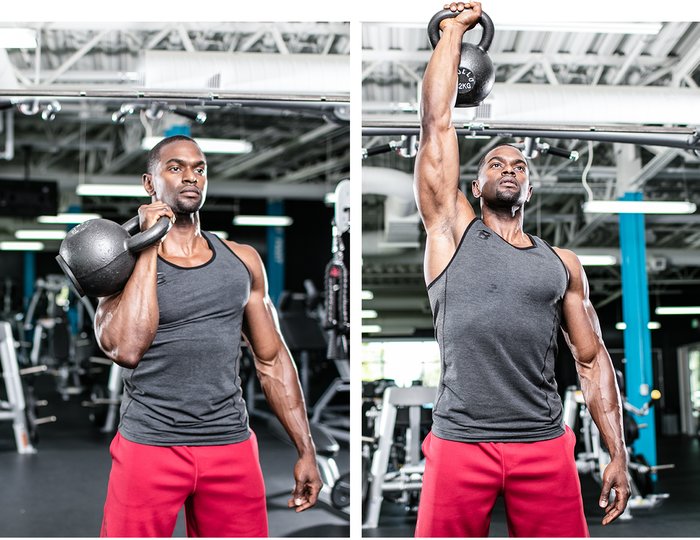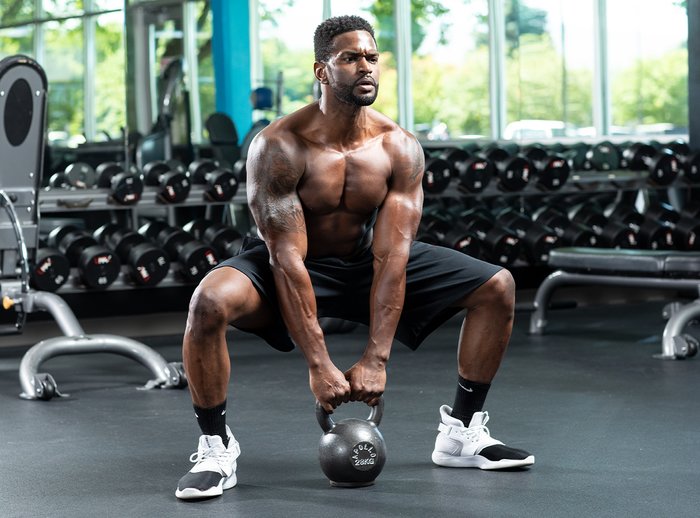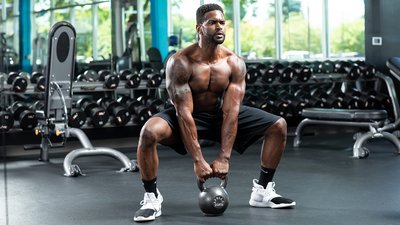There are many reasons to like kettlebells, but let's talk about just two. The biggest, for me, is that they allow us to practice—and instruct—the most important human movements in ways that are approachable, but incredibly powerful.
For example, I think the kettlebell swing—done correctly—teaches and reinforces the most powerful thing a human can do: hinge at the hips. It's also a world-class fat-burning athlete builder. And the kettlebell squat, especially the goblet squat (invented, humbly, by me) is the best gateway there is to deep squatting and appropriate positioning. Just those two can change lives and careers. I have used both with huge athletic engines from the NFL, NBA, MLB, the military, and the Olympic world, and with plenty of everyday people who have no desire to be in those worlds. But in both cases, we have made progress.
The second reason is that kettlebells are the master tool for increasing density in your training. Density can be explained simply: "Same work, less time." Later, it becomes "more work, less time." Complexes and circuits are part of the density world, but let me add one more for you: drumlines.
Not one you know? Allow me to lead you in one.
Get in Step
I have no idea why this became the name for these workouts. I looked back over my notes and saw that we started using them toward the beginning of the new millennia. On a hunch, I looked up the term and found that a movie called "Drumline" came out in 2002. It's a film…don't be shocked…about drumlines.

But going back before that, I have always enjoyed the idea of "following the leader" in training. Watch me do something, and then it's your turn. With drumlines, we take this a bit further.
It's basically this: In a fairly random order, stretch out a few kettlebells (or dumbbells or other weights) in a line. Have some space between each—this will depend on your facility and number of bells—so a person can do the lift safely and not hit a partner. I have 26 KBs in my home gym, so we lay them out down the sidewalk. The most basic workout is this:
Drumline Option 1
- Clean and press the first bell with the left arm—just one rep.
- Move to the next bell and clean and press it with the right arm.
- Continue along until you do all your bells, and begin again with the right arm.
There will be a lot of load changes and variation along the way, and you can accomplish a pretty substantial amount of work without ever feeling, well, worked. If a bell is too heavy to press, skip it, clean it, or just deadlift it with good form.
Drumline Option 2
Another great drumline protocol is to use just three bells. I recommend this order: medium, light, heavy.
Start the exercise with the medium bell, do the reps, move to the light, do the reps, then finish with the heavy bell and finish the reps. If you are doing a one-handed lift, like clean and press or snatch, start with the left hand on round one, right hand on round two, and keep going.

There are many ways you can make this work for different movements. A few include:
- Swings: 10 reps with each bell
- Snatches: 5 reps with each bell
- Clean and presses: Singles with each bell (although you could do one clean and three presses occasionally with a lighter weight.)
- Goblet squats: 3 or 5 reps with each bell
If you have the bells to make it work, double clean and presses and double front squats are both brutal with the medium-light-heavy template.
Drumline Option 3
Can you simply go up or down with weight? Well, of course. This is what I call the "rack walk-up" or "rack walk-down," and it's the basis for my six-week primer for squatting from the book "Mass Made Simple." It can work if you have a big selection of kettlebells at your disposal, but also if you have the standard dumbbell rack in any commercial gym.
If you are a raw beginner and a man, the goal for this is to do a 100-pound goblet squat in just six weeks using this plan. A woman could aim for the same weight, but could also get great benefits from aiming for, say, 70-75 pounds. No matter what weight you use, the form is the same: Your upper body stays rigid so your glutes, quadriceps, and hamstrings do most of the heavy lifting.
Seventy to 100 may not sound all that impressive, but wait until you try it. Once you're able to bang out a few sets of 10 with triple-digit weight, you'll realize the full-body benefits of squats.
Weeks 1 and 2: Hone your technique. Five days a week, perform 2-3 sets of at least 5, and as many as 20 goblet squats. Use a light dumbbell, or even a heavy book.

Week 3: Do squats three days a week, resting for at least a day between sessions. You'll improve your technique and increase strength and muscle endurance.
- Day 1: Perform a rack walk-up. Grab the lightest dumbbell or kettlebell you can find and do a set of 5 goblet squats. Return the weight to the rack and grab the next heaviest. The exchange should take you no more than 20 seconds. Do another set, then continue moving up the rack until you find a weight that's challenging to lift but still allows perfect technique.
- Day 2: Do the reverse of Day 1: a rack walk-down. Start with your second-heaviest weight from Day 1, and complete a set of 5 reps. Move down the rack, lifting a lighter weight for each set of 5. Aim for a total of 10-12 sets, resting for no more than 20 seconds between sets.
- Day 3: Combine your workouts from Day 1 and Day 2. You'll start by moving up in weight, performing sets of 5 reps. When you reach your heaviest weight, work back down the rack. Rest for two days before your next squat workout.
Week 4: Same as Week 3, but perform 3 reps with each dumbbell, using heavier weights than in your last workout.
Week 5: By now you should feel comfortable performing the goblet squat. So let's focus on building muscle and strength. Again, rest for at least a day between workouts.
- Day 1: Do 2 sets of 20 reps using a weight that challenges you in the last 5 reps. Rest for 2 minutes between sets.
- Day 2: Choose a weight that makes it difficult to complete 10 reps. Do 3 sets of 8 reps, resting 60 seconds between sets.
- Day 3: Perform a rack walk-up. Do 3 reps with each weight and stop when you feel your technique beginning to falter.

Week 6: This week's theme is simple: If you can pick it up, you can squat it.
- Day 1: Do the regular rack walk-down, performing 3 reps per set with a heavy weight. Then do it again, this time starting with a slightly heavier weight. Rest for no more than 20 seconds between sets and for 30 seconds between walk-downs.
- Day 2: Do a couple of light warm-up sets of goblet squats, then do the rack walk-up twice. Do 3 reps per set and rest for up to 30 seconds between sets.
- Day 3: Do a few easy sets to warm up. Then find the heaviest dumbbell you can lift—aim for three digits—and perform the goblet squat.
Why Drumlines Work
First, and this might be the whole key to its efficacy, when using the "follow the leader" approach, we tend to skip counting reps and sets or obsessing over percentages. We simply do what someone else did. I go, you go. No matter how many steps or moves or things we have to do, I watched you do it: so, I do it. Even when you train alone, oddly, the drumline works.
Second, you will find that these workouts have "built in" volume, intensity, waving the load, density, and all the other factors that make up appropriate programing. As you will learn, stepping over to the next bell is, yes, the rest period, but it also gives you a chance to reassess the load, reassess the need for intensity and reassess the fact that "Hell, I made it his far, I might as well keep going." I swear that my mind sees the weights as simply dominoes that I am knocking over one after another.
When people show up unexpectedly to train, we often turn the "workout" into a drumline. Of course, we will do the mobility work, the glute drills, the practice and teaching of movements and the other stuff, but the meat of the program will be the drumline. And using the "if the bell is too heavy, skip it or deadlift it" rule means the workout can easily be scaled to different strength levels and ages.
Drumlines are a great change of pace. Drumlines can be used as a very quick training session. Drumlines can reinforce technical training, while also doing what's needed to get you stronger. If those aren't enough to make it worth keeping in the rotation, then I don't know what is.
Is the swing your thing? Do you understand the joy that comes with a kettlebell overhead? Then FYR: Hannah Eden's 30-Day Fitness Plan is for you. In five workouts a week, you'll sweat, swear, and learn plenty of new tricks to do with your old bells.

